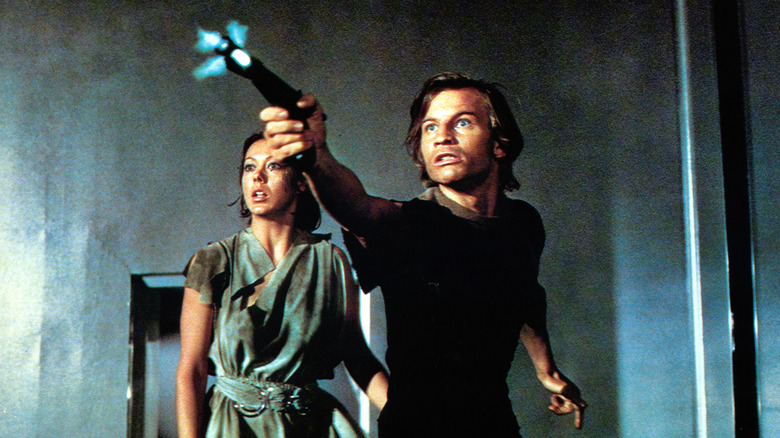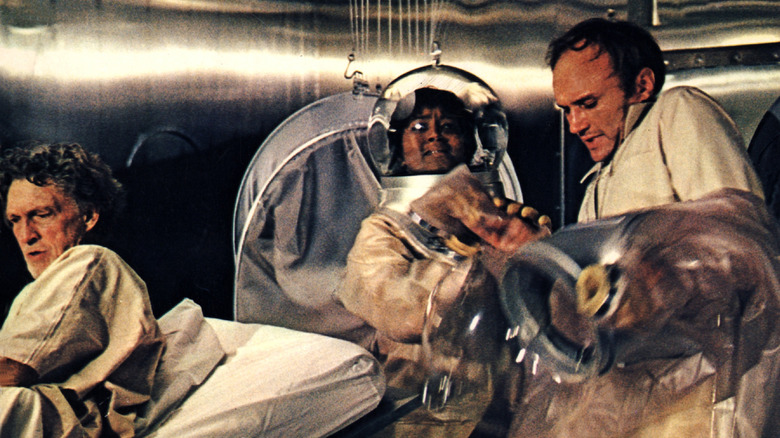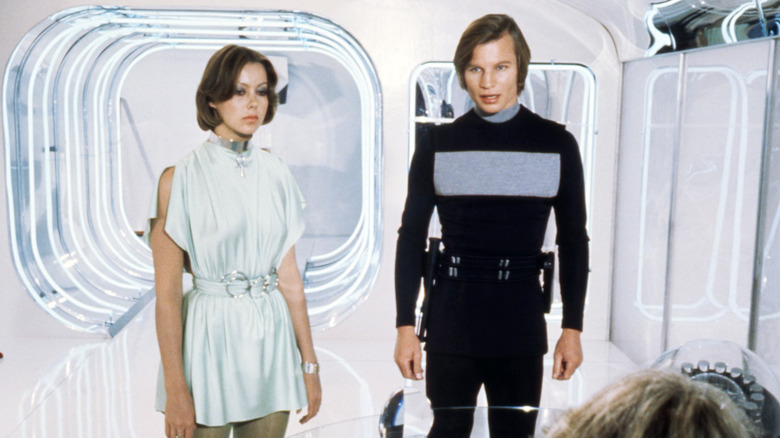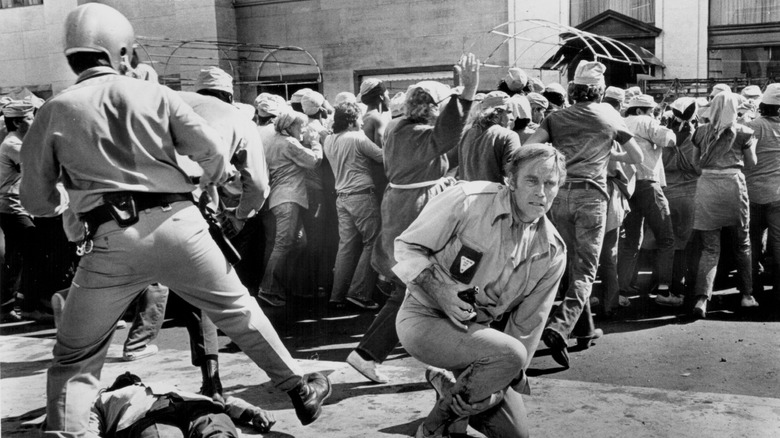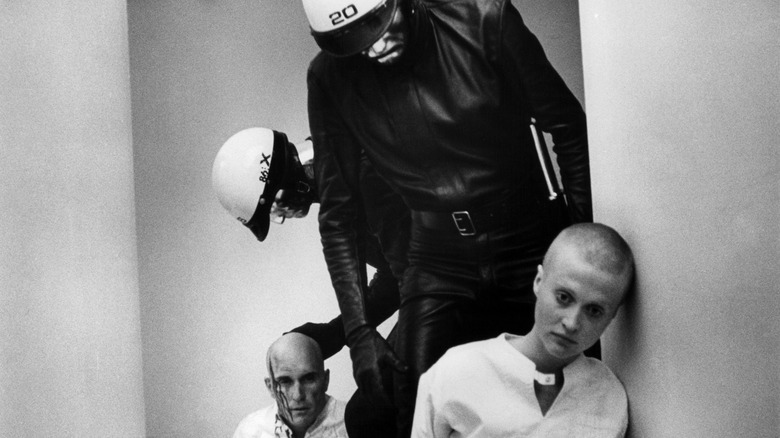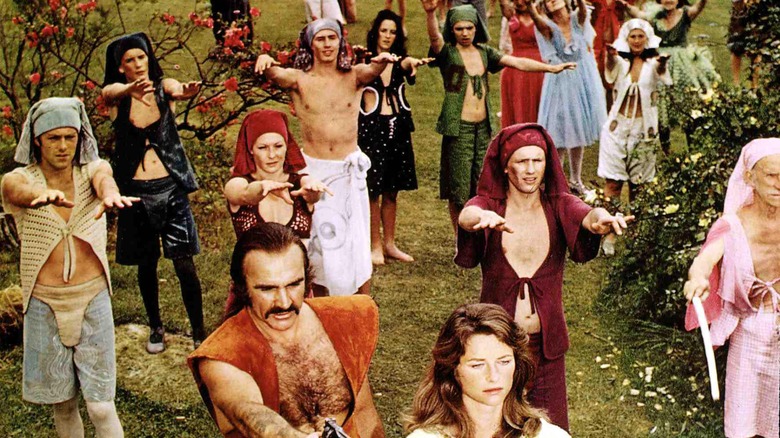5 Underrated '70s Sci-Fi Movies We Completely Forgot About
Long before "quantum" became the sci-fi byword for "we don't understand what we're writing," sci-fi diehards and casual fans alike dined on decades of superlative sci-fi films. The '80s saw the superb sequel "Aliens" expand on its original to forge a masterpiece in its own right, much like "Terminator 2: Judgment Day" did in the '90s. The '00s, meanwhile, saw writers tweak existing ideas into high-concept films like "Children of Men" and "District 9." But before all these films came a decade of massive hits and lesser-discussed films that laid the groundwork for them all: the '70s.
The 1970s were replete with legendary sci-fi touchstones that not only defined the genre, but also defined entire generations of moviegoers, notably "Star Wars," "Alien," and "Close Encounters of the Third Kind." These films ran the gamut from cerebral and horrific to grounded, action-packed, fantastical, and everything in between. But for every major, well-remembered hit, loads of other films have slipped from collective memory, much like any art. Uber-fans exist for all projects, but we're talking about film recognition in the eyes of the wider public.
Some lesser-cited '70s sci-fi has stuck around in public consciousness even if only for iconic visuals and contemporary sequels, such as "Mad Max," while other films have recognizable names even if folks know nothing of the film, like "Invasion of the Body Snatchers." Then there are those 1970s films that have faded from the public eye, yet are more than worthy of recognition. In no particular order, five of these are "The Andromeda Strain"; "Logan's Run"; "Soylent Green"; "THX 1138," and because we can't resist Sean Connery's chest hair, "Zardoz."
The Andromeda Strain
1971's "The Andromeda Strain" is an ultra-serious, hyper-realistic film, which eschews the far future for a near-future that highlights a topic that all of us who lived through COVID-19 will find suitably terrifying: the outbreak of a deadly pathogen. There's a containment lab in Nevada, robot-armed medical machines conducting viralogical research, bodies littering a small desert town, and the brightest scientific minds racing against time to prevent a global pandemic. If anyone wondered where 1995's Dustin Hoffman-led "Outbreak" got its inspiration, it's this movie. The only truly speculative element in "The Andromeda Strain" is that the pathogen is of extraterrestrial origin.
While we've got director Robert Wise to thank for the film, we've got the renowned Michael Crichton to thank for the 1969 novel that inspired it. Crichton, best known for having penned "Jurassic Park" and "Sphere," basically invented the grounded, hard sci-fi, technothriller subgenre, and it shows all over "The Andromeda Strain." The film is smart, severe in tone, takes itself seriously, and features scientists who are actually good at doing their jobs and don't behave like morons ("Prometheus," we're looking at you).
"The Andromeda Strain" performed well at the box office, making over $12 million (about $96 million in 2025) on a $6.5 million budget. But no matter how good it is, the movie's lack of escapism might have driven it from collective memory. "Jurassic Park," by contrast, is a fun movie romp with lots of dumb stuff that is very different from its far more sterile book version. But for folks who don't mind living through COVID-19 PTSD, "The Andromeda Strain" awaits.
Logan's Run
Folks who've seen the 1976 movie "Logan's Run" might recall a bizarre, jarring collection of imagery and set pieces more than anything else. Shiny, plastic-looking surfaces embedded with neon tubes, a dude with a laser blaster escaping a retro-futuristic city that looks like a mall (because the film was actually shot in a mall), an ice cave with a robot, some ritual where red-clad participants stand in a circle and float into the air, and a collage of other whackadoolde moments. But, it's the high concept that viewers might remember more than anything else: Folks get euthanized when they reach the age of 30.
Part exploration of humanity's endless search for meaning and part send-up of modernity's tendency to delay adulthood, "Logan's Run" sits on the cusp of shtick and sincerity. Based on the brief 1967 book of the same name by William F. Nolan and George Clayton Johnson, the movie features actor Michael York as Logan, the main character. Logan is a hunter of runners turned runner himself, i.e., one of those who tries to escape mandatory execution at age 30. The plot involves him fleeing a sheltered city of hedonism into a shattered, 23rd-century, post-apocalyptic world. He then sets about breaking others free of their belief in a social contract that insists that they need to die at 30.
No matter that "Logan's Run" isn't a supremely well-known film, it was a hit when it came out, garnering $25 million (about $142 million in 2025) on a $7 million budget. That being said, the themes of "Logan's Run" are so on-the-nose and obvious that some blame it for the shift away from high-concept sci-fi, and towards the modern blockbuster era; "Star Wars" came out the very next year.
Soylent Green
In "Soylent Green," the year is 2022, and society is a dysfunctional, overpopulated morass of poverty, crime, and corporate-controlled life necessities. Sound familiar? The murder of a Soylent Corp executive leads a detective — played by Charlton Heston — to a conspiracy tied to a vile secret rotting in the recesses of big agro. Spoiler alert: Soylent Green, the synthetic food substance that so many of the world's impoverished rely on for food, is made from human corpses.
Much like "Logan's Run" and "The Andromeda Strain," 1973's "Soylent Green" is based on a sci-fi novel, in this case 1966's "Make Room! Make Room!" by Harry Harrison. His book featured not Soylent Green, but soylent steaks, faux-meat steaks made from a combination of soybeans and lentils — so basically, meatless products that exist nowadays in the frozen foods section of every grocery store. Besides the soylent naming connection, "Soylent Green" bears little resemblance to its original novel. Harrison thought that the 1971, part-environmentalist, part-detective, and part dystopian movie provided a better dramatic punch than his book, but called shenanigans on corpses being able to provide enough food for the living.
No matter its less-than-well-known status, "Soylent Green" lives on not just in memory but in recipes. The Kale Factory has a Soylent Green shake that gets its green from — surprise, surprise — kale. One Facebook user posted a Soylent Green nutrition bar recipe that swaps out lentils for corn on Wednesday, "Soylent Yellow Day," and includes "freeze-fried people" as an ingredient (presumably as a joke). We've got no idea if Harry Harrison would find this all in, ahem, poor taste.
THX 1138
Those familiar with 2002's "Equilibrium" will find the set-up to 1971's "THX 1138" all too familiar. An Orwellian surveillance state where citizens are controlled by emotion-suppressing drugs? Check. A fight-the-system narrative centered on a main character who starts as a patsy of said system? Check. Said main character starting his anti-authoritarian journey because of his connection to his partner, who, Eve-like, first succumbs to the whispers of her innermost, awakening self? Check. Now swap out Christian Bale for the ever-excellent, award-winning Robert Duvall, lose the post-Matrix, gunplay-meets-kung-fu gimmick, add a big dose of consumerist criticism, and you've sort of got "THX 1138." The film was also directed by George Lucas, who at the time was an artsy auteur, not the guy who essentially pioneered the special effects-laden blockbuster via "Star Wars."
And speaking of artsy, "THX 1138" is definitely the most arthouse of the films on this list. Much of its sentiments and themes are communicated through visual language and sound, like the usage of impersonal, hard-angled interiors and flat, white surfaces. There's not a whole lot of dialogue, either. Even the name of the film is that of Duvall's shaven-headed character, implying that humanity in the film's underground city is effectively composed of prisoners designated by dehumanizing IDs. His great act of heresy is wanting a connection to another person and demonstrating that connection through physical love. Then there's the robot police force, a literally inhuman retinue of enforcers who can never demonstrate empathy. All in all, there's a lot to recommend "THX 1138" for, especially because it might actually be the most overlooked of all of our films.
Zardoz
There are a lot of excellent and overlooked '70s sci-fi films left to choose from, but we've got to end on something a bit sillier and lighter than the foreboding fare we've covered so far. For that, there's no better place to turn than 1974's "Zardoz," a movie where Sean Connery — who once disarmed a real-life gangster on set — goes topless except for a red bandolier, matching banana hammock, and thigh-high boots. Indeed, much of the rest of the cast goes topless in a plot that seems stitched together from a teenager's bulleted list of "Dude, wouldn't it be cool if ..." concepts. It's not too hard to see why "Zardoz" has fallen by the wayside, but at the same time, it's perfect for those wanting a gonzo, trippy take on '70s sci-fi.
More futuristic fantasy than straight sci-fi, the plot of "Zardoz" is full of proper nouns and entangled factions. There's a big, floating god statue called Zardoz that controls the lives of those in a future wasteland called the Outlands. Connery (Zed) is an "Exterminator" who is allowed to breed and also, judging by his prop, carry a revolver from the 1900s. Exterminators fight "Brutals, who are the lowest caste, while immortal "Eternals" live in a closed-off utopia. Fast forwarding through a whole bunch of nonsense, Zed and an Eternal, Consuela, accept the normal cycle of life and death by having a kid. In the end, Zardoz's masterful ending shot might just elevate it from cult classic to something poignant.
